 | ÐлекÑÑоннÑй компоненÑ: AD5300B | СкаÑаÑÑ:  PDF PDF  ZIP ZIP |
/home/web/htmldatasheet/RUSSIAN/html/ad/210852
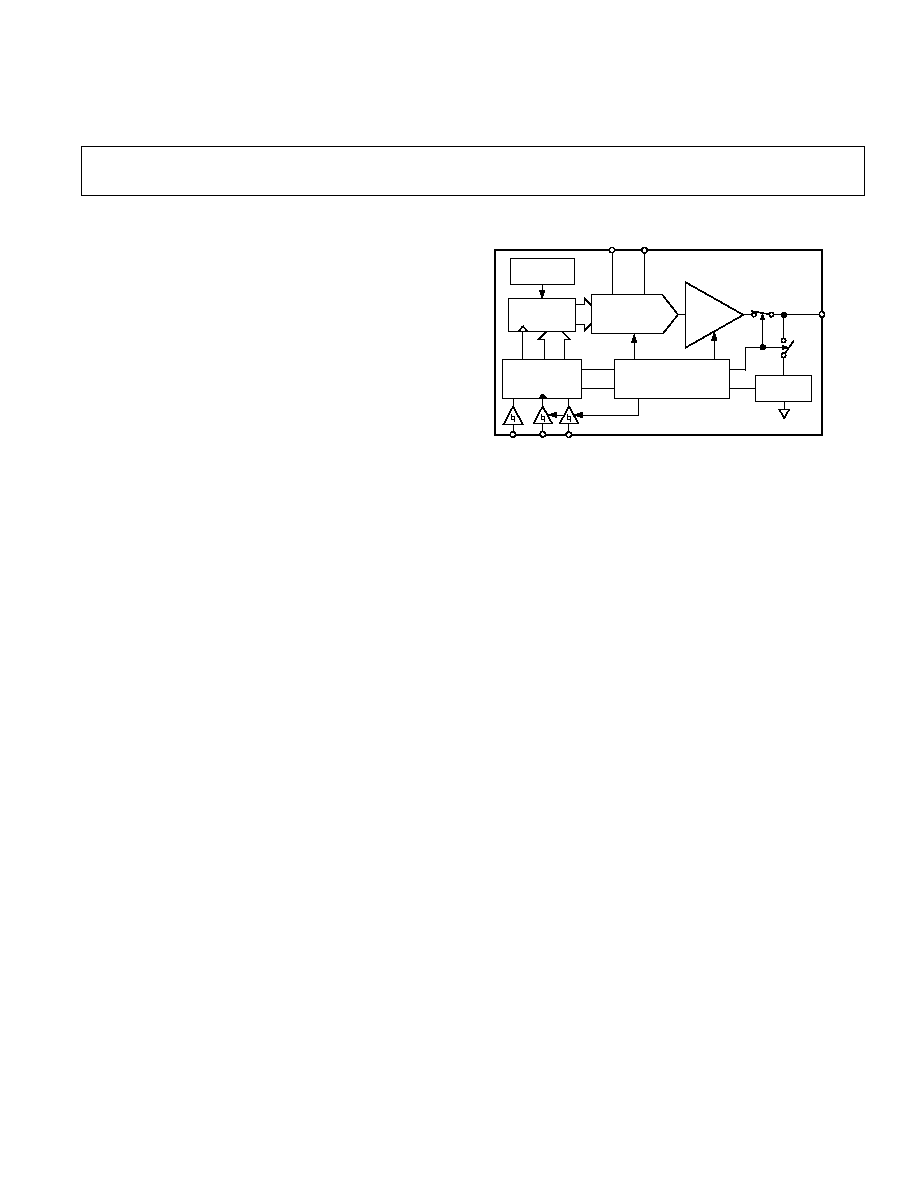
REV. B
Information furnished by Analog Devices is believed to be accurate and
reliable. However, no responsibility is assumed by Analog Devices for its
use, nor for any infringements of patents or other rights of third parties
which may result from its use. No license is granted by implication or
otherwise under any patent or patent rights of Analog Devices.
a
AD5300*
One Technology Way, P.O. Box 9106, Norwood, MA 02062-9106, U.S.A.
Tel: 781/329-4700
World Wide Web Site: http://www.analog.com
Fax: 781/326-8703
© Analog Devices, Inc., 2000
2.7 V to 5.5 V, 140 A, Rail-to-Rail Output
8-Bit DAC in an SOT-23
FUNCTIONAL BLOCK DIAGRAM
POWER-ON
RESET
DAC
REGISTER
INPUT
CONTROL
LOGIC
AD5300
V
DD
GND
V
OUT
SYNC SCLK DIN
8-BIT
DAC
REF (+) REF ()
OUTPUT
BUFFER
POWER-DOWN
CONTROL LOGIC
RESISTOR
NETWORK
FEATURES
Single 8-Bit DAC
6-Lead SOT-23 and 8-Lead SOIC Packages
Micropower Operation: 140 A @ 5 V
Power-Down to 200 nA @ 5 V, 50 nA @ 3 V
2.7 V to 5.5 V Power Supply
Guaranteed Monotonic by Design
Reference Derived from Power Supply
Power-On-Reset to Zero Volts
Three Power-Down Functions
Low Power Serial Interface with Schmitt-Triggered
Inputs
On-Chip Output Buffer Amplifier, Rail-to-Rail
Operation
SYNC Interrupt Facility
APPLICATIONS
Portable Battery Powered Instruments
Digital Gain and Offset Adjustment
Programmable Voltage and Current Sources
Programmable Attenuators
GENERAL DESCRIPTION
The AD5300 is a single, 8-bit buffered voltage out DAC that
operates from a single 2.7 V to 5.5 V supply consuming 115
µA
at 3 V. Its on-chip precision output amplifier allows rail-to-rail
output swing to be achieved. The AD5300 utilizes a versatile
three-wire serial interface that operates at clock rates up to 30 MHz
and is compatible with standard SPITM, QSPITM, MICROWIRETM
and DSP interface standards.
The reference for AD5300 is derived from the power supply
inputs and thus gives the widest dynamic output range. The part
incorporates a power-on-reset circuit that ensures that the DAC
output powers up to zero volts and remains there until a valid
write takes place to the device. The part contains a power-down
feature that reduces the current consumption of the device to
200 nA at 5 V and provides software selectable output loads
while in power-down mode. The part is put into power-down
mode over the serial interface.
The low power consumption of this part in normal operation
makes it ideally suited to portable battery operated equipment.
The power consumption is 0.7 mW at 5 V reducing to 1
µW in
power-down mode.
The AD5300 is one of a family of pin-compatible DACs. The
AD5310 is the 10-bit version and the AD5320 is the 12-bit
version. The AD5300/AD5310/AD5320 are available in 6-lead
SOT-23 packages and 8-lead
µSOIC packages.
PRODUCT HIGHLIGHTS
1. Available in 6-lead SOT-23 and 8-lead
µSOIC packages.
2. Low power, single supply operation. This part operates from
a single 2.7 V to 5.5 V supply and typically consumes 0.35 mW
at 3 V and 0.7 mW at 5 V, making it ideal for battery pow-
ered applications.
3. The on-chip output buffer amplifier allows the output of the
DAC to swing rail-to-rail with a slew rate of 1 V/
µs.
4. Reference derived from the power supply.
5. High speed serial interface with clock speeds up to 30 MHz.
Designed for very low power consumption. The interface
only powers up during a write cycle.
6. Power-down capability. When powered down the DAC
typically consumes 50 nA at 3 V and 200 nA at 5 V.
SPI and QSPI are trademarks of Motorola, Inc.
MICROWIRE is a trademark of National Semiconductor Corporation.
*Patent pending; protected by U.S. Patent No. 5684481.

2
REV. B
AD5300SPECIFICATIONS
(V
DD
= 2.7 V to 5.5 V; R
L
= 2 k
to GND; C
L
= 500 pF to GND; all specifications
T
MIN
to T
MAX
unless otherwise noted.)
B Version
1
Parameter
Min
Typ
Max
Unit
Conditions/Comments
STATIC PERFORMANCE
2
Resolution
8
Bits
Relative Accuracy
± 1
LSB
See Figure 2.
Differential Nonlinearity
±0.25
LSB
Guaranteed Monotonic by Design. See Figure 3.
Zero Code Error
+0.5
+3.5
LSB
All Zeros Loaded to DAC Register. See Figure 6.
Full-Scale Error
0.5
3.5
LSB
All Ones Loaded to DAC Register. See Figure 6.
Gain Error
±1.25
% of FSR
Zero Code Error Drift
20
µV/°C
Gain Temperature Coefficient
5
ppm of FSR/
°C
OUTPUT CHARACTERISTICS
3
Output Voltage Range
0
V
DD
V
Output Voltage Settling Time
4
6
µs
1/4 Scale to 3/4 Scale Change (40 Hex to C0 Hex).
R
L
= 2 k
; 0 pF < C
L
< 500 pF. See Figure 16.
Slew Rate
1
V/
µs
Capacitive Load Stability
470
pF
R
L
=
1000
pF
R
L
= 2 k
Digital-to-Analog Glitch Impulse
20
nV-s
1 LSB Change Around Major Carry. See Figure 19.
Digital Feedthrough
0.5
nV-s
DC Output Impedance
1
Short Circuit Current
50
mA
V
DD
= 5 V
20
mA
V
DD
= 3 V
Power-Up Time
2.5
µs
Coming Out of Power-Down Mode. V
DD
= 5 V
5
µs
Coming Out of Power-Down Mode. V
DD
= 3 V
LOGIC INPUTS
3
Input Current
± 1
µA
V
INL
, Input Low Voltage
0.8
V
V
DD
= 5 V
V
INL
, Input Low Voltage
0.6
V
V
DD
= 3 V
V
INH
, Input High Voltage
2.4
V
V
DD
= 5 V
V
INH
, Input High Voltage
2.1
V
V
DD
= 3 V
Pin Capacitance
3
pF
POWER REQUIREMENTS
V
DD
2.7
5.5
V
I
DD
(Normal Mode)
DAC Active and Excluding Load Current
V
DD
= 4.5 V to 5.5 V
140
250
µA
V
IH
= V
DD
and V
IL
= GND
V
DD
= 2.7 V to 3.6 V
115
200
µA
V
IH
= V
DD
and V
IL
= GND
I
DD
(All Power-Down Modes)
V
DD
= 4.5 V to 5.5 V
0.2
1
µA
V
IH
= V
DD
and V
IL
= GND
V
DD
= 2.7 V to 3.6 V
0.05
1
µA
V
IH
= V
DD
and V
IL
= GND
POWER EFFICIENCY
I
OUT
/I
DD
93
%
I
LOAD
= 2 mA. V
DD
= 5 V
NOTES
1
Temperature ranges are as follows: B Version: 40
°C to +105°C.
2
Linearity
calculated using a reduced code range of 4 to 251. Output unloaded.
3
Guaranteed by design and characterization, not production tested.
Specifications subject to change without notice.
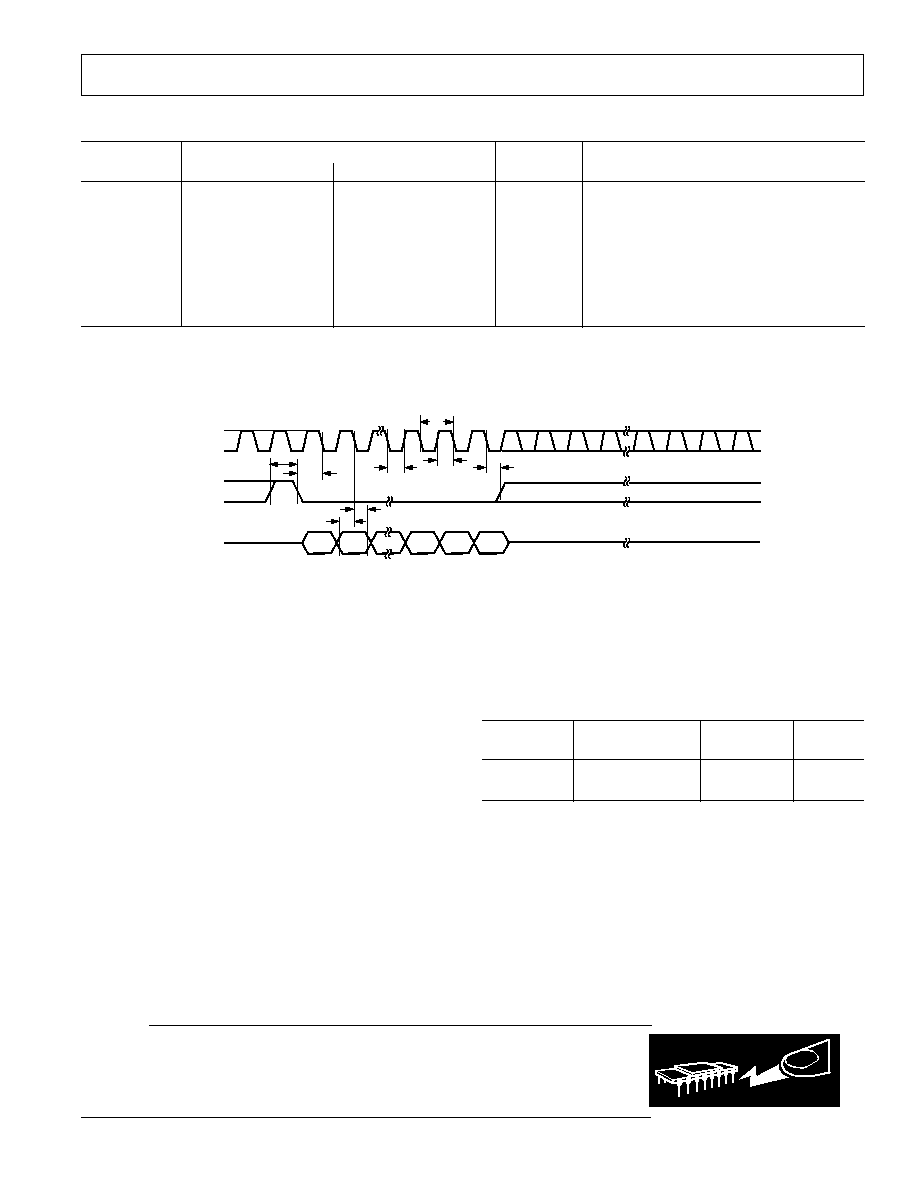
AD5300
3
REV. B
TIMING CHARACTERISTICS
1, 2
Limit at T
MIN
, T
MAX
Parameter
V
DD
= 2.7 V to 3.6 V
V
DD
= 3.6 V to 5.5 V
Unit
Conditions/Comments
t
1
3
50
33
ns min
SCLK Cycle Time
t
2
13
13
ns min
SCLK High Time
t
3
22.5
13
ns min
SCLK Low Time
t
4
13
13
ns min
SYNC to SCLK Falling Edge Setup Time
t
5
5
5
ns min
Data Setup Time
t
6
4.5
4.5
ns min
Data Hold Time
t
7
0
0
ns min
SCLK Falling Edge to
SYNC Rising Edge
t
8
50
33
ns min
Minimum
SYNC High Time
NOTES
1
All input signals are specified with tr = tf = 5 ns (10% to 90% of V
DD
) and timed from a voltage level of (V
IL
+ V
IH
)/2.
2
See Figure 1.
3
Maximum SCLK frequency is 30 MHz at V
DD
= 3.6 V to 5.5 V and 20 MHz at V
DD
= 2.7 V to 3.6 V.
Specifications subject to change without notice.
SCLK
SYNC
DIN
t
8
DB15
DB0
t
4
t
3
t
2
t
7
t
5
t
6
t
1
Figure 1. Serial Write Operation
(V
DD
= 2.7 V to 5.5 V; all specifications T
MIN
to T
MAX
unless otherwise noted.)
ABSOLUTE MAXIMUM RATINGS
*
(T
A
= 25
°C unless otherwise noted)
V
DD
to GND . . . . . . . . . . . . . . . . . . . . . . . . . . 0.3 V to +7 V
Digital Input Voltage to GND . . . . . . . 0.3 V to V
DD
+ 0.3 V
V
OUT
to GND . . . . . . . . . . . . . . . . . . . 0.3 V to V
DD
+ 0.3 V
Operating Temperature Range
Industrial (B Version) . . . . . . . . . . . . . . . 40
°C to +105°C
Storage Temperature Range . . . . . . . . . . . . 65
°C to +150°C
Junction Temperature (T
J
Max) . . . . . . . . . . . . . . . . . . 150
°C
SOT-23 Package
Power Dissipation . . . . . . . . . . . . . . . . . . . (T
J
MaxT
A
)/
JA
JA
Thermal Impedance . . . . . . . . . . . . . . . . . . . . 240
°C/W
Lead Temperature, Soldering
Vapor Phase (60 sec) . . . . . . . . . . . . . . . . . . . . . . . 215
°C
Infrared (15 sec) . . . . . . . . . . . . . . . . . . . . . . . . . . 220
°C
µSOIC Package
Power Dissipation . . . . . . . . . . . . . . . . . . . (T
J
MaxT
A
)/
JA
JA
Thermal Impedance . . . . . . . . . . . . . . . . . . . . 206
°C/W
JC
Thermal Impedance . . . . . . . . . . . . . . . . . . . . . 44
°C/W
Lead Temperature, Soldering
Vapor Phase (60 sec) . . . . . . . . . . . . . . . . . . . . . . . 215
°C
Infrared (15 sec) . . . . . . . . . . . . . . . . . . . . . . . . . . 220
°C
*Stresses above those listed under Absolute Maximum Ratings may cause perma-
nent damage to the device. This is a stress rating only; functional operation of the
device at these or any other conditions above those listed in the operational sections
of this specification is not implied. Exposure to absolute maximum rating condi-
tions for extended periods may affect device reliability.
ORDERING GUIDE
Temperature
Branding
Package
Model
Range
Information Option
*
AD5300BRT
40
°C to +105°C
D2B
RT-6
AD5300BRM
40
°C to +105°C
D2B
RM-8
*RT = SOT-23; RM =
µSOIC.
CAUTION
ESD (electrostatic discharge) sensitive device. Electrostatic charges as high as 4000 V readily
accumulate on the human body and test equipment and can discharge without detection.
Although the AD5300 features proprietary ESD protection circuitry, permanent damage may
occur on devices subjected to high-energy electrostatic discharges. Therefore, proper ESD
precautions are recommended to avoid performance degradation or loss of functionality.
WARNING!
ESD SENSITIVE DEVICE

AD5300
4
REV. B
PIN CONFIGURATIONS
TOP VIEW
(Not to Scale)
6
5
4
1
2
3
V
OUT
GND
V
DD
SYNC
SCLK
DIN
AD5300
TOP VIEW
(Not to Scale)
8
7
6
5
1
2
3
4
NC
AD5300
SYNC
V
OUT
GND
V
DD
SCLK
DIN
NC
NC = NO CONNECT
SOT-23
SOIC
PIN FUNCTION DESCRIPTIONS
SOT-23 Pin Numbers
Pin
No.
Mnemonic
Function
1
V
OUT
Analog output voltage from DAC. The output amplifier has rail-to-rail operation.
2
GND
Ground reference point for all circuitry on the part.
3
V
DD
Power Supply Input. These parts can be operated from 2.5 V to 5.5 V and V
DD
should be decoupled
to GND.
4
DIN
Serial Data Input. This device has a 16-bit shift register. Data is clocked into the register on the
falling edge of the serial clock input.
5
SCLK
Serial Clock Input. Data is clocked into the input shift register on the falling edge of the serial clock
input. Data can be transferred at rates up to 30 MHz.
6
SYNC
Level triggered control input (active low). This is the frame synchronization signal for the input
data. When
SYNC goes low, it enables the input shift register and data is transferred in on the fall-
ing edges of the following clocks. The DAC is updated following the 16th clock cycle unless
SYNC
is taken high before this edge in which case the rising edge of
SYNC acts as an interrupt and the
write sequence is ignored by the DAC.

AD5300
5
REV. B
TERMINOLOGY
Relative Accuracy
For the DAC, relative accuracy or Integral Nonlinearity (INL)
is a measure of the maximum deviation, in LSBs, from a straight
line passing through the endpoints of the DAC transfer func-
tion. A typical INL vs. code plot can be seen in Figure 2.
Differential Nonlinearity
Differential Nonlinearity (DNL) is the difference between the
measured change and the ideal 1 LSB change between any two
adjacent codes. A specified differential nonlinearity of
±1 LSB
maximum ensures monotonicity. This DAC is guaranteed
monotonic by design. A typical DNL vs. code plot can be seen
in Figure 3.
Zero-Code Error
Zero-code error is a measure of the output error when zero code
(00 Hex) is loaded to the DAC register. Ideally the output
should be 0 V. The zero-code error is always positive in the
AD5300 because the output of the DAC cannot go below 0 V.
It is due to a combination of the offset errors in the DAC and
output amplifier. Zero-code error is expressed in LSBs. A plot
of zero-code error vs. temperature can be seen in Figure 6.
Full-Scale Error
Full-scale error is a measure of the output error when full-scale
code (FF Hex) is loaded to the DAC register. Ideally the output
should be V
DD
1 LSB. Full-scale error is expressed in LSBs. A
plot of full-scale error vs. temperature can be seen in Figure 6.
Gain Error
This is a measure of the span error of the DAC. It is the devia-
tion in slope of the DAC transfer characteristic from ideal ex-
pressed as a percent of the full-scale range.
Total Unadjusted Error
Total Unadjusted Error (TUE) is a measure of the output error
taking into account all the various errors. A typical TUE vs.
code plot can be seen in Figure 4.
Zero-Code Error Drift
This is a measure of the change in zero-code error with a
change in temperature. It is expressed in
µV/°C.
Gain Error Drift
This is a measure of the change in gain error with changes in
temperature. It is expressed in (ppm of full-scale range)/
°C.
Digital-to-Analog Glitch Impulse
Digital-to-analog glitch impulse is the impulse injected into the
analog output when the input code in the DAC register changes
state. It is normally specified as the area of the glitch in nV secs
and is measured when the digital input code is changed by
1 LSB at the major carry transition (7F Hex to 80 Hex). See
Figure 19.
Digital Feedthrough
Digital feedthrough is a measure of the impulse injected into the
analog output of the DAC from the digital inputs of the DAC,
but is measured when the DAC output is not updated. It is
specified in nV secs and is measured with a full-scale code
change on the data bus, i.e., from all 0s to all 1s and vice versa.

CODE
INL ERROR
LSBs
1
0.5
1
0
50
250
100
150
200
0
0.5
INL @ 3V
INL @ 5V
T
A
= 25 C
Figure 2. Typical INL Plot
TEMPERATURE C
ERROR
LSBs
1
0.5
1
40
0
120
40
80
0
0.5
MAX INL
MIN INL
MAX DNL
MIN DNL
V
DD
= 5V
Figure 5. INL Error and DNL Error
vs. Temperature
I
SOURCE/SINK
mA
V
OUT
V
3
2
0
0
5
15
10
1
DAC LOADED WITH FF HEX
T
A
= 25 C
DAC LOADED WITH 00 HEX
Figure 8. Source and Sink Current
Capability with V
DD
= 3 V
CODE
DNL ERROR
LSBs
0.5
0.4
0.5
0
50
250
100
150
200
0.1
0.2
0.3
0.4
0.3
0.1
0.2
0
T
A
= 25 C
DNL @ 5V
DNL @ 3V
Figure 3. Typical DNL Plot
TEMPERATURE C
3
2
3
40
120
0
40
80
0
1
V
DD
= 5V
ERROR
LSBs
2
1
ZS ERROR
FS ERROR
Figure 6. Zero-Scale Error and Full-
Scale Error vs. Temperature
I
SOURCE/SINK
mA
V
OUT
V
5
4
0
0
5
15
10
3
2
1
DAC LOADED WITH 00 HEX
T
A
= 25 C
DAC LOADED WITH FF HEX
Figure 9. Source and Sink Current
Capability with V
DD
= 5 V
CODE
TUE
LSBs
1.0
0.5
1.0
0
50
250
100
150
200
0
0.5
T
A
= 25 C
TUE @ 5V
TUE @ 3V
Figure 4. Typical Total Unadjusted
Error Plot
2500
2000
500
50
1500
1000
0
FREQUENCY
70
90
110
130
150
170
190
60
80
100
120
140
160
180
V
DD
= 3V
V
DD
= 5V
I
DD
A
Figure 7. I
DD
Histogram with
V
DD
= 3 V and V
DD
= 5 V
CODE
I
DD
A
500
400
0
0
50
250
100
150
200
300
200
100
V
DD
= 3V
V
DD
= 5V
Figure 10. Supply Current vs. Code
AD5300Typical Performance Characteristics
6
REV. B
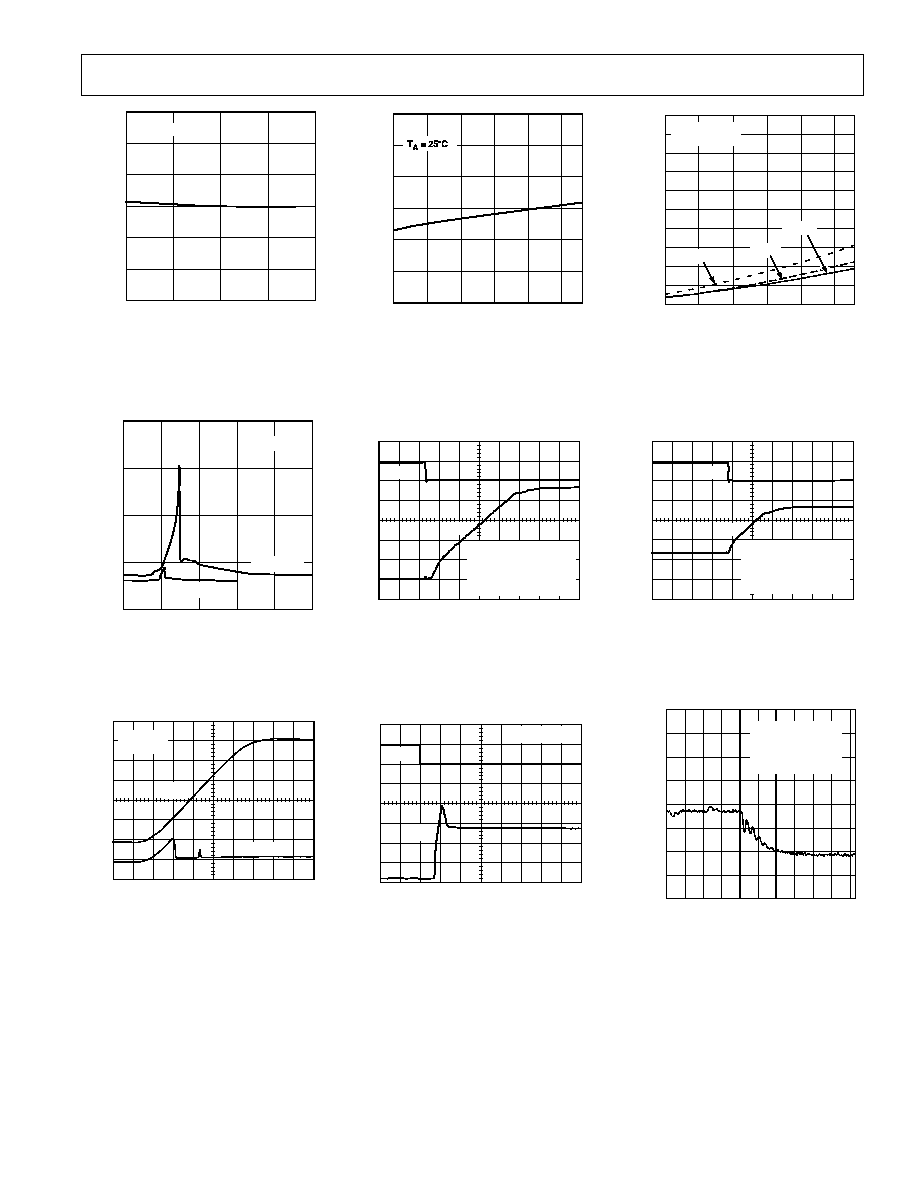
AD5300
7
REV. B
TEMPERATURE C
I
DD
A
0
40
80
0
40
300
100
50
120
V
DD
= 5V
150
200
250
Figure 11. Supply Current vs.
Temperature
V
LOGIC
V
800
600
0
0
1
5
2
3
4
400
200
T
A
= 25 C
V
DD
= 5V
V
DD
= 3V
I
DD
A
Figure 14. Supply Current vs. Logic
Input Voltage
2k LOAD
TO V
DD
CH1 1V, CH 2 1V, TIME BASE = 20 s/DIV
V
DD
V
OUT
CH1
CH2
Figure 17. Power-On Reset to 0 V
V
DD
V
I
DD
A
300
250
0
2.7
3.2
5.2
3.7
4.2
4.7
200
150
100
50
Figure 12. Supply Current vs. Supply
Voltage
V
OUT
CLK
CH1 1V, CH 2 5V, TIME BASE = 1 s/DIV
CH1
CH 2
V
DD
= 5V
FULL-SCALE CODE CHANGE
00 HEX FF HEX
T
A
= 25 C
OUTPUT LOADED WITH
2k AND 200pF TO GND
Figure 15. Full-Scale Settling Time
CH1 1V, CH 2 5V, TIME BASE = 5 s/DIV
CH2
CH1
CLK
V
OUT
V
DD
= 5V
Figure 18. Exiting Power-Down
(7F Hex Loaded)
V
DD
V
1.0
0.9
0
2.7
3.2
5.2
3.7
4.2
4.7
0.4
0.3
0.2
0.1
0.8
0.6
0.7
0.5
THREESTATE
CONDITION
40 C
+25 C
+105 C
I
DD
A
Figure 13. Power-Down Current vs.
Supply Voltage
V
OUT
CLK
V
DD
= 5V
HALF-SCALE CODE CHANGE
40 HEX C0 HEX
T
A
= 25 C
OUTPUT LOADED WITH
2k AND 200pF TO GND
CH1 1V, CH2 5V, TIME BASE = 1 s/DIV
CH 1
CH 2
Figure 16. Half-Scale Settling Time
V
OUT
V
500ns/DIV
2.54
2.46
2.50
2.48
2.52
LOADED WITH 2k
AND 200pF TO GND
CODE CHANGE:
80 HEX TO 7F HEX
Figure 19. Digital-to-Analog Glitch
Impulse
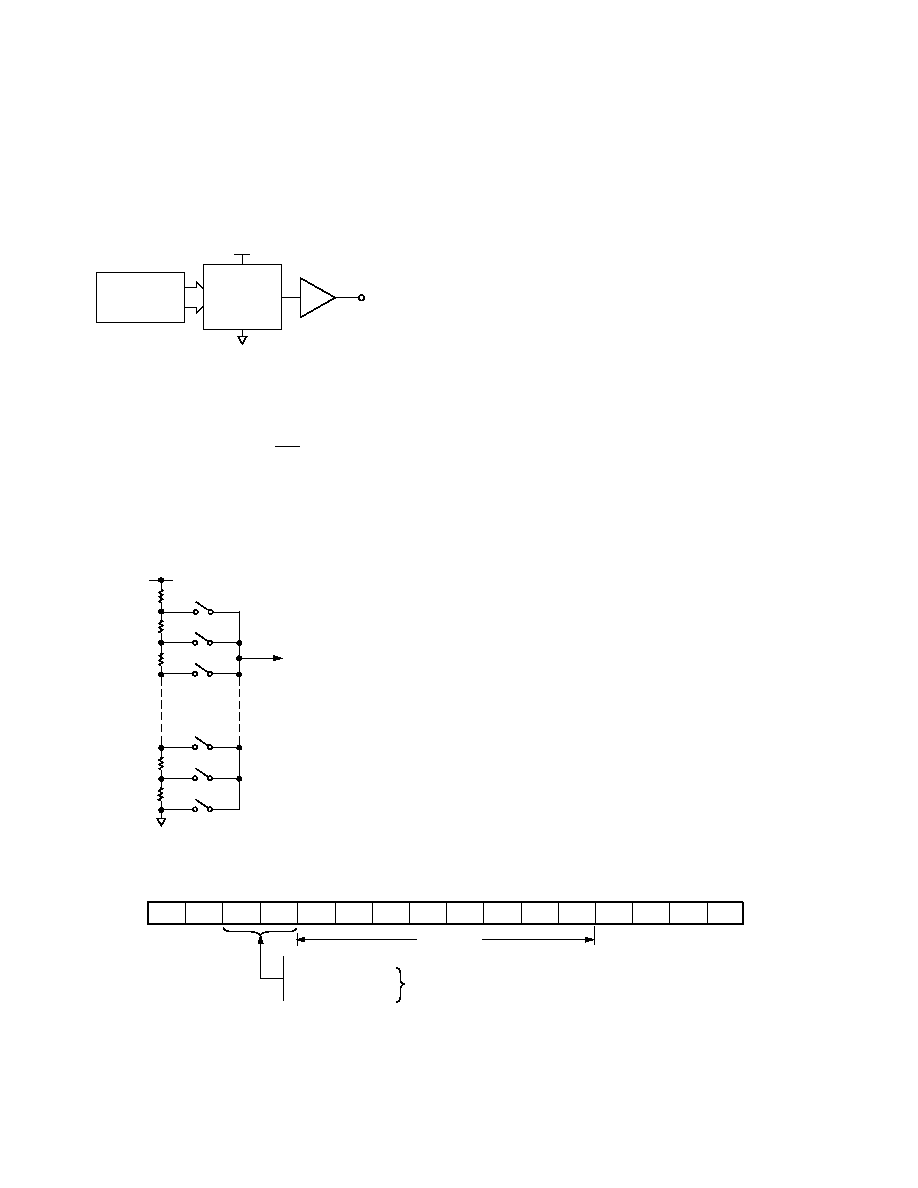
AD5300
8
REV. B
GENERAL DESCRIPTION
D/A Section
The AD5300 DAC is fabricated on a CMOS process. The archi-
tecture consists of a string DAC followed by an output buffer
amplifier. Since there is no reference input pin, the power
supply (V
DD
) acts as the reference. Figure 20 shows a block
diagram of the DAC architecture.
V
DD
V
OUT
GND
RESISTOR
STRING
REF (+)
REF ()
OUTPUT
AMPLIFIER
DAC REGISTER
Figure 20. DAC Architecture
Since the input coding to the DAC is straight binary, the ideal
output voltage is given by:
V
OUT
=V
DD
×
D
256
where D = decimal equivalent of the binary code that is loaded
to the DAC register; it can range from 0 to 255.
Resistor String
The resistor string section is shown in Figure 21. It is simply a
string of resistors, each of value R. The code loaded to the DAC
R
R
TO OUTPUT
AMPLIFIER
R
R
R
Figure 21. Resistor String
register determines at which node on the string the voltage is
tapped off to be fed into the output amplifier. The voltage is
tapped off by closing one of the switches connecting the string
to the amplifier. Because it is a string of resistors, it is guaran-
teed monotonic.
Output Amplifier
The output buffer amplifier is capable of generating rail-to-rail
voltages on its output which gives an output range of 0 V to
V
DD
. It is capable of driving a load of 2 k
in parallel with
1000 pF to GND. The source and sink capabilities of the output
amplifier can be seen in Figures 8 and 9. The slew rate is 1 V/
µs
with a half-scale settling time of 4
µs with the output loaded.
SERIAL INTERFACE
The AD5300 has a three-wire serial interface (
SYNC, SCLK
and DIN), which is compatible with SPI, QSPI and MICROWIRE
interface standards as well as most DSPs. See Figure 1 for a
timing diagram of a typical write sequence.
The write sequence begins by bringing the
SYNC line low. Data
from the DIN line is clocked into the 16-bit shift register on the
falling edge of SCLK. The serial clock frequency can be as high
as 30 MHz, making the AD5300 compatible with high-speed
DSPs. On the sixteenth falling clock edge, the last data bit is
clocked in and the programmed function is executed (i.e., a
change in DAC register contents and/or a change in the mode of
operation). At this stage, the
SYNC line may be kept low or be
brought high. In either case, it must be brought high for a mini-
mum of 33 ns (V
DD
= 3.6 V to 5.5 V) or 50 ns (V
DD
= 2.7 V to
3.6 V) before the next write sequence so that a falling edge of
SYNC can initiate the next write sequence. Since the SYNC
buffer draws more current when V
IN
= 2.4 V than it does when
V
IN
= 0.8 V,
SYNC should be idled low between write sequences
for even lower power operation of the part. As is mentioned
above, however, it must be brought high again just before the
next write sequence.
Input Shift Register
The input shift register is 16 bits wide (see Figure 22). The first
two bits are "don't cares." The next two are control bits that
control which mode of operation the part is in (normal mode or
any one of three power-down modes). There is a more complete
description of the various modes in the Power-Down Modes
section. The next eight bits are the data bits. These are trans-
ferred to the DAC register on the sixteenth falling edge of SCLK.
Finally, the last four bits are "don't cares."
DB0 (LSB)
DB15 (MSB)
0
0
NORMAL OPERATION
0
1
1k TO GND
1
0
100k TO GND
1
1
THREE-STATE
POWER-DOWN MODES
DATA BITS
X
X
PD1
PD 0
D7
D6
D5
D4
D3
D2
D1
D0
X
X
X
X
Figure 22. Input Register Contents
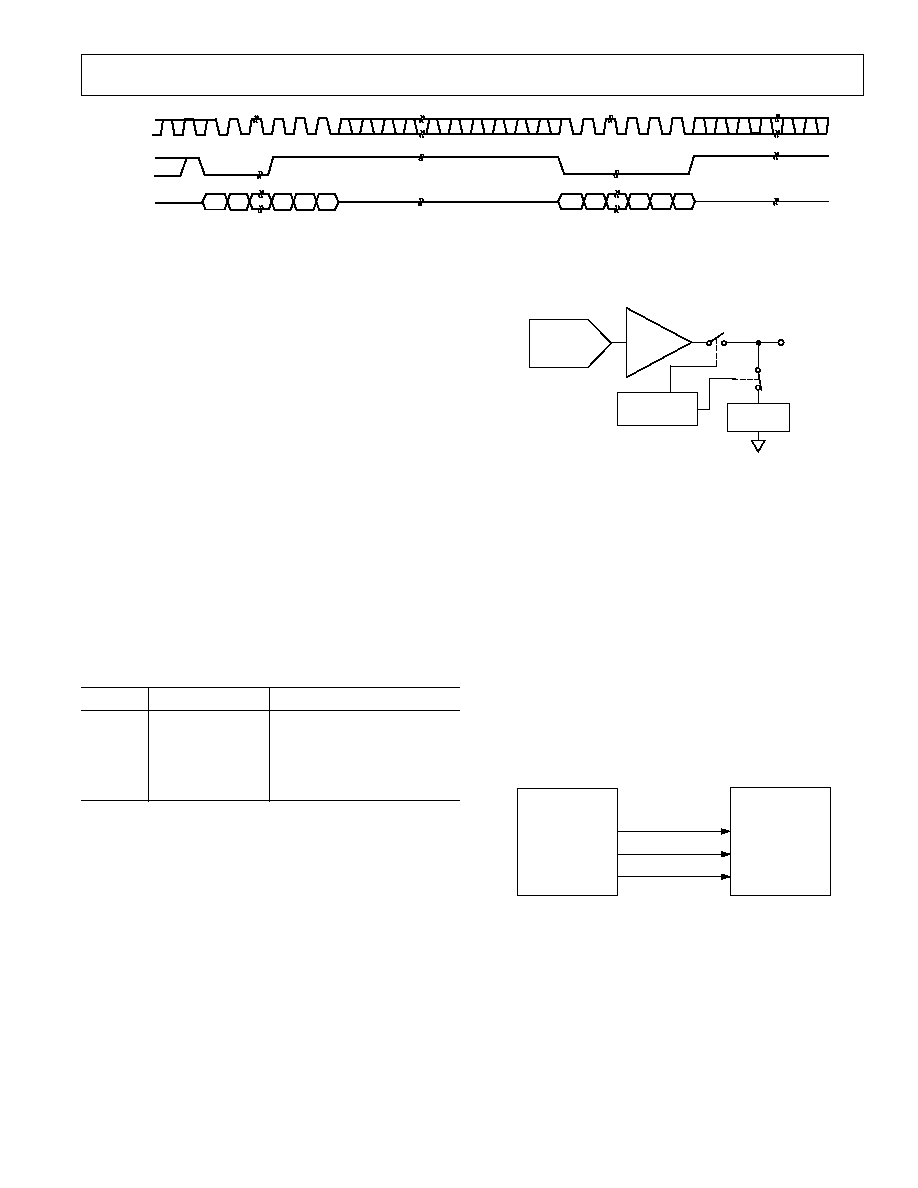
AD5300
9
REV. B
POWER-DOWN
CIRCUITRY
RESISTOR
NETWORK
V
OUT
RESISTOR
STRING DAC
AMPLIFIER
Figure 24. Output Stage During Power-Down
The bias generator, the output amplifier, the resistor string and
other associated linear circuitry are all shut down when the
power-down mode is activated. However, the contents of the
DAC register are unaffected when in power-down. The time to
exit power-down is typically 2.5
µs for V
DD
= 5 V and 5
µs for
V
DD
= 3 V. See Figure 18 for a plot.
MICROPROCESSOR INTERFACING
AD5300 to ADSP-2101/ADSP-2103 Interface
Figure 25 shows a serial interface between the AD5300 and the
ADSP-2101/ADSP-2103. The ADSP-2101/ADSP-2103 should
be set up to operate in the SPORT Transmit Alternate Framing
Mode. The ADSP-2101/ADSP-2103 SPORT is programmed
through the SPORT control register and should be configured
as follows: Internal Clock Operation, Active Low Framing, 16-
Bit Word Length. Transmission is initiated by writing a word to
the Tx register after the SPORT has been enabled.
ADSP-2101/
ADSP-2103*
DT
*ADDITIONAL PINS OMITTED FOR CLARITY
SYNC
DIN
SCLK
AD5300*
TFS
SCLK
Figure 25. AD5300 to ADSP-2101/ADSP-2103 Interface
DB15
DB0
SCLK
SYNC
DIN
DB15
DB0
VALID WRITE SEQUENCE, OUTPUT UPDATES
ON THE 16
TH
FALLING EDGE
INVALID WRITE SEQUENCE:
SYNC HIGH BEFORE 16
TH
FALLING EDGE
Figure 23.
SYNC Interrupt Facility
SYNC Interrupt
In a normal write sequence, the
SYNC line is kept low for at
least 16 falling edges of SCLK and the DAC is updated on the
16th falling edge. However, if
SYNC is brought high before the
16th falling edge this acts as an interrupt to the write sequence.
The shift register is reset and the write sequence is seen as
invalid. Neither an update of the DAC register contents or a
change in the operating mode occurs--see Figure 23.
Power-On-Reset
The AD5300 contains a power-on-reset circuit which controls
the output voltage during power-up. The DAC register is filled
with zeros and the output voltage is 0 V. It remains there until
a valid write sequence is made to the DAC. This is useful in
applications where it is important to know the state of the out-
put of the DAC while it is in the process of powering up.
Power-Down Modes
The AD5300 contains four separate modes of operation. These
modes are software-programmable by setting two bits (DB13
and DB12) in the control register. Table I shows how the state
of the bits corresponds to the mode of operation of the device.
Table I. Modes of Operation for the AD5300
DB13
DB12
Operating Mode
0
0
Normal Operation
Power-Down Modes
0
1
1 k
to GND
1
0
100 k
to GND
1
1
Three-State
When both bits are set to 0, the part works normally with its
normal power consumption of 140
µA at 5 V. However, for the
three power-down modes, the supply current falls to 200 nA at
5 V (50 nA at 3 V). Not only does the supply current fall but
the output stage is also internally switched from the output of
the amplifier to a resistor network of known values. This has the
advantage that the output impedance of the part is known while
the part is in power-down mode. There are three different options.
The output is connected internally to GND through a 1 k
resis-
tor, a 100 k
resistor or it is left open-circuited (Three-State).
The output stage is illustrated in Figure 24.
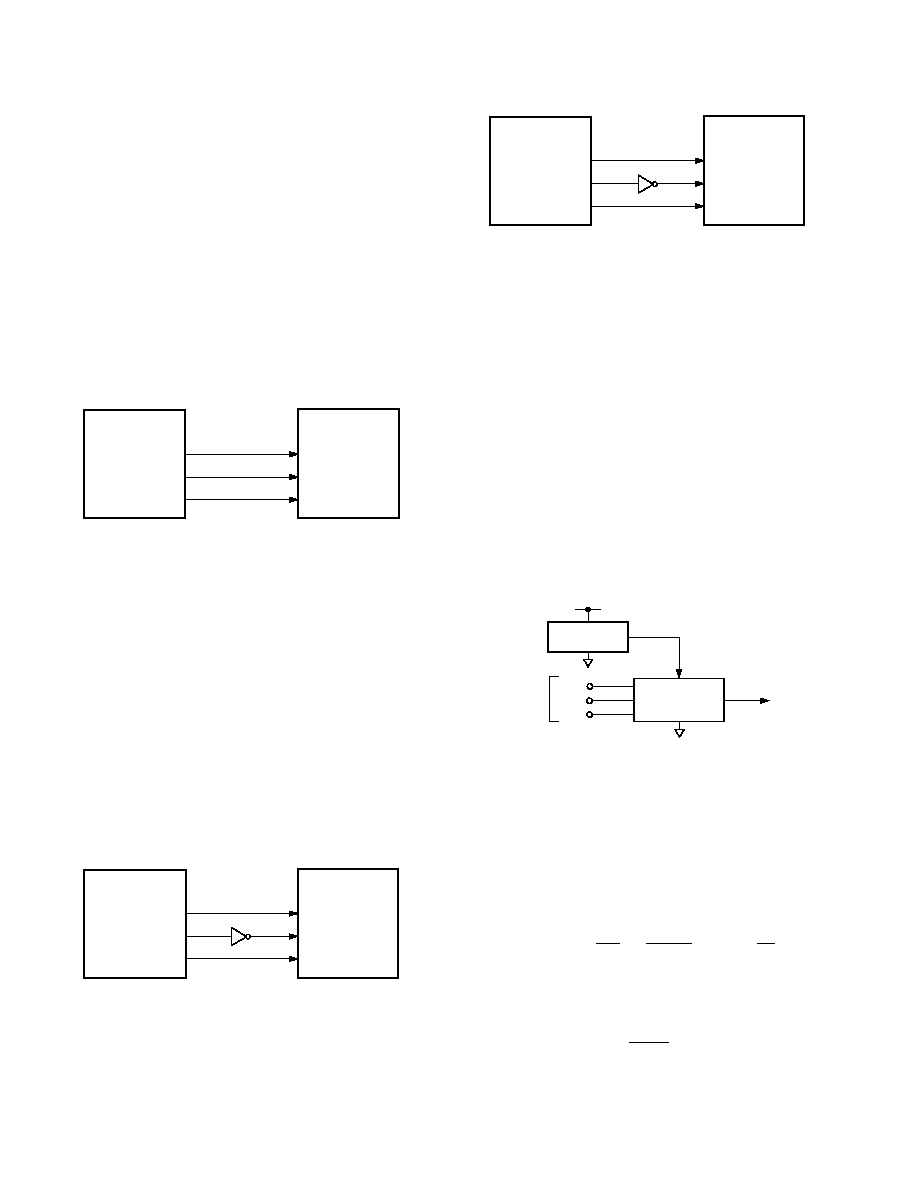
AD5300
10
REV. B
*ADDITIONAL PINS OMITTED FOR CLARITY
SYNC
DIN
AD5300*
SCLK
MICROWIRE*
SK
SO
CS
Figure 28. AD5300 to MICROWIRE Interface
APPLICATIONS
Using REF19x as a Power Supply for AD5300
Because the supply current required by the AD5300 is extremely
low, an alternative option is to use a REF19x voltage reference
(REF195 for 5 V or REF193 for 3 V) to supply the required
voltage to the part--see Figure 29. This is especially useful if
your power supply is quite noisy or if the system supply voltages
are at some value other than 5 V or 3 V (e.g., 15 V). The REF19x
will output a steady supply voltage for the AD5300. If the low
dropout REF195 is used, the current it needs to supply to the
AD5300 is 140
µA. This is with no load on the output of the
DAC. When the DAC output is loaded, the REF195 also needs to
supply the current to the load. The total current required (with
a 5 k
load on the DAC output) is:
140
µA + (5 V/5 k) = 1.14 mA
The load regulation of the REF195 is typically 2 ppm/mA,
which results in an error of 2.3 ppm (11.5
µV) for the 1.14 mA
current drawn from it. This corresponds to a 0.0006 LSB error.
AD5300
THREE-WIRE
SERIAL
INTERFACE
SYNC
SCLK
DIN
15V
5V
140 A
V
OUT
= 0V TO 5V
REF195
Figure 29. REF195 as Power Supply to AD5300
Bipolar Operation Using the AD5300
The AD5300 has been designed for single-supply operation, but
a bipolar output range is also possible using the circuit in Figure
30. The circuit below will give an output voltage range of
±5 V.
Rail-to-rail operation at the amplifier output is achievable using
an AD820 or an OP295 as the output amplifier.
The output voltage for any input code can be calculated as
follows:
V
O
= V
DD
×
D
256
×
R1
+ R2
R1
V
DD
×
R2
R1
where D represents the input code in decimal (0255).
With V
DD
= 5 V, R1 = R2 = 10 k
:
V
O
=
10
× D
256
5V
This is an output voltage range of
±5 V with 00 Hex corresponding
to a 5 V output and FF Hex corresponding to a 5 V output.
AD5300 to 68HC11/68L11 Interface
Figure 26 shows a serial interface between the AD5300 and the
68HC11/68L11 microcontroller. SCK of the 68HC11/68L11
drives the SCLK of the AD5300, while the MOSI output drives
the serial data line of the DAC. The
SYNC signal is derived
from a port line (PC7). The setup conditions for correct opera-
tion of this interface are as follows: the 68HC11/68L11 should
be configured so that its CPOL bit is a 0 and its CPHA bit is a
1. When data is being transmitted to the DAC, the
SYNC line is
taken low (PC7). When the 68HC11/68L11 is configured as
above, data appearing on the MOSI output is valid on the falling
edge of SCK. Serial data from the 68HC11/68L11 is transmit-
ted in 8-bit bytes with only eight falling clock edges occurring in
the transmit cycle. Data is transmitted MSB first. In order to
load data to the AD5300, PC7 is left low after the first eight bits
are transferred, and a second serial write operation is performed
to the DAC and PC7 is taken high at the end of this procedure.
*ADDITIONAL PINS OMITTED FOR CLARITY
SYNC
DIN
AD5300*
SCLK
68HC11/68L11*
SCK
MOSI
PC7
Figure 26. AD5300 to 68HC11/68L11 Interface
AD5300 to 80C51/80L51 Interface
Figure 27 shows a serial interface between the AD5300 and the
80C51/80L51 microcontroller. The setup for the interface is as
follows: TXD of the 80C51/80L51 drives SCLK of the AD5300,
while RXD drives the serial data line of the part. The
SYNC
signal is again derived from a bit programmable pin on the port.
In this case port line P3.3 is used. When data is to be transmit-
ted to the AD5300, P3.3 is taken low. The 80C51/80L51 trans-
mits data only in 8-bit bytes; thus only eight falling clock edges
occur in the transmit cycle. To load data to the DAC, P3.3 is
left low after the first eight bits are transmitted, and a second
write cycle is initiated to transmit the second byte of data. P3.3
is taken high following the completion of this cycle. The 80C51/
80L51 outputs the serial data in a format which has the LSB
first. The AD5300 requires its data with the MSB as the first bit
received. The 80C51/80L51 transmit routine should take this
into account.
*ADDITIONAL PINS OMITTED FOR CLARITY
SYNC
DIN
AD5300*
SCLK
80C51/80L51*
TXD
RXD
P3.3
Figure 27. AD5300 to 80C51/80L51 Interface
AD5300 to Microwire Interface
Figure 28 shows an interface between the AD5300 and any
microwire compatible device. Serial data is shifted out on the
falling edge of the serial clock and is clocked into the AD5300
on the rising edge of the SK.
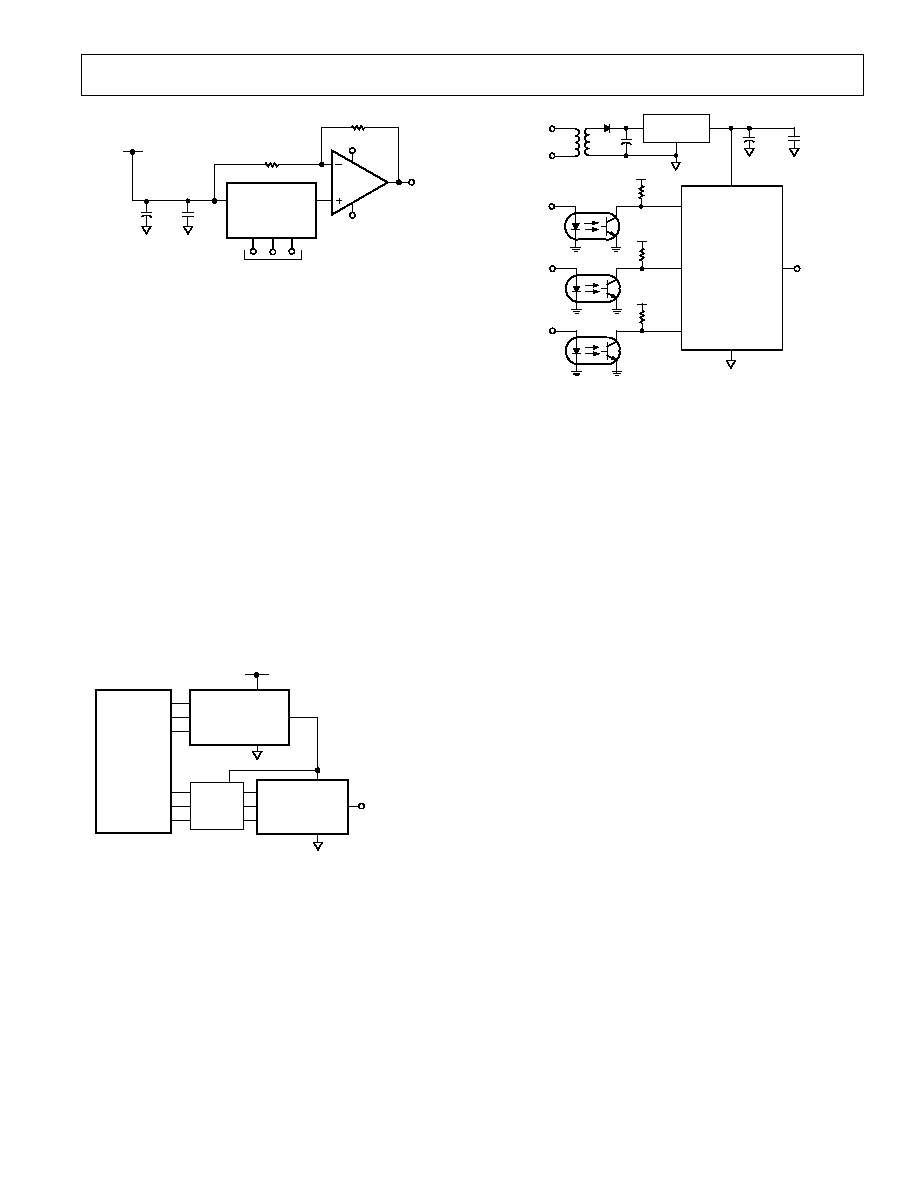
AD5300
11
REV. B
0.1 F
V
DD
10k
POWER
10 F
V
DD
SYNC
SCLK
DATA
AD5300
5V
REGULATOR
V
DD
10k
V
DD
10k
V
OUT
DIN
SYNC
SCLK
GND
Figure 32. AD5300 with an Opto-Isolated Interface
Power Supply Bypassing and Grounding
When accuracy is important in a circuit it is helpful to carefully
consider the power supply and ground return layout on the
board. The printed circuit board containing the AD5300 should
have separate analog and digital sections, each having its own
area of the board. If the AD5300 is in a system where other
devices require an AGND to DGND connection, the connec-
tion should be made at one point only. This ground point should
be as close as possible to the AD5300.
The power supply to the AD5300 should be bypassed with
10
µF and 0.1 µF capacitors. The capacitors should be physi-
cally as close as possible to the device with the 0.1
µF capacitor
ideally right up against the device. The 10
µF capacitors are the
tantalum bead type. It is important that the 0.1
µF capacitor
has low Effective Series Resistance (ESR) and Effective Series
Inductance (ESI), e.g., common ceramic types of capacitors. This
0.1
µF capacitor provides a low impedance path to ground for
high frequencies caused by transient currents due to internal
logic switching.
The power supply line itself should have as large a trace as pos-
sible to provide a low impedance path and reduce glitch effects
on the supply line. Clocks and other fast switching digital signals
should be shielded from other parts of the board by digital
ground. Avoid crossover of digital and analog signals if possible.
When traces cross on opposite sides of the board, ensure that
they run at right angles to each other to reduce feedthrough
effects through the board. The best board layout technique is
the microstrip technique where the component side of the board
is dedicated to the ground plane only and the signal traces are
placed on the solder side. However, this is not always possible
with a two-layer board.
R2 = 10k
+5V
5V
AD820/
OP295
THREE-WIRE
SERIAL
INTERFACE
+5V
AD5300
10 F
0.1 F
V
DD
V
OUT
R1 = 10k
5V
Figure 30. Bipolar Operation with the AD5300
Two 8-Bit AD5300s Together Make One 15-Bit DAC
By using the configuration below in Figure 31, it can be seen
that one 15-bit DAC can be made with two 8-bit AD5300s.
Because of the low supply current the AD5300 requires, the
output of one DAC may be directed into the supply pin of the
second DAC. The first DAC has no problem sourcing the
required 140
µA of current for the second DAC.
Since the AD5300 works on any supply voltage between 2.5 V
and 5.5 V, the output of the first DAC can be anywhere above
2.5 V. For a V
DD
of 5 V this allows the first DAC to use half of
its output range (2.5 V to 5 V), which gives 7-bit resolution on
the output voltage. This output then becomes the supply and
reference for the second DAC. The second DAC has 8-bit reso-
lution on the output range, which gives an overall resolution for
the system of 15 bits.
A level-shifter is required to ensure that the logic input voltages
do not exceed the supply voltage of the part. The microcontroller
outputs 5 V signals which need to be level-shifted down to 2.5 V
in the case of the second DAC having a supply of only 2.5 V.
5V
MICRO-
CONTROLLER
V
OUT
= 2.5V TO 5V
LEVEL
SHIFTER
V
OUT
= 0V TO 5V
15-BIT
RESOLUTION
SYNC
SCLK
DIN
V
DD
AD5300
AD5300
V
DD
SYNC
SCLK
DIN
Figure 31. 15-Bit DAC Using Two AD5300s
Using AD5300 with an Opto-Isolated Interface
In process-control applications in industrial environments it is
often necessary to use an opto-isolated interface to protect and
isolate the controlling circuitry from any hazardous common-
mode voltages that may occur in the area where the DAC is
functioning. Opto-isolators provide isolation in excess of 3 kV.
Because the AD5300 uses a three-wire serial logic interface, it
requires only three opto-isolators to provide the required isola-
tion (see Figure 32). The power supply to the part also needs to
be isolated. This is done by using a transformer. On the DAC
side of the transformer, a 5 V regulator provides the 5 V supply
required for the AD5300.

AD5300
12
REV. B
OUTLINE DIMENSIONS
Dimensions shown in inches and (mm).
C00471b310/00 (rev. B)
PRINTED IN U.S.A.
6-Lead SOT-23
(RT-6)
0.122 (3.10)
0.106 (2.70)
PIN 1
0.071 (1.80)
0.059 (1.50)
0.118 (3.00)
0.098 (2.50)
0.075 (1.90)
BSC
0.037 (0.95) BSC
1
3
4
5
6
2
0.009 (0.23)
0.003 (0.08)
0.022 (0.55)
0.014 (0.35)
10°
0°
0.020 (0.50)
0.010 (0.25)
0.006 (0.15)
0.000 (0.00)
0.051 (1.30)
0.035 (0.90)
SEATING
PLANE
0.057 (1.45)
0.035 (0.90)
8-Lead SOIC
(RM-8)
8
5
4
1
0.122 (3.10)
0.114 (2.90)
0.199 (5.05)
0.187 (4.75)
PIN 1
0.0256 (0.65) BSC
0.122 (3.10)
0.114 (2.90)
SEATING
PLANE
0.006 (0.15)
0.002 (0.05)
0.018 (0.46)
0.008 (0.20)
0.043 (1.09)
0.037 (0.94)
0.120 (3.05)
0.112 (2.84)
0.011 (0.28)
0.003 (0.08)
0.028 (0.71)
0.016 (0.41)
33°
27°
0.120 (3.05)
0.112 (2.84)











